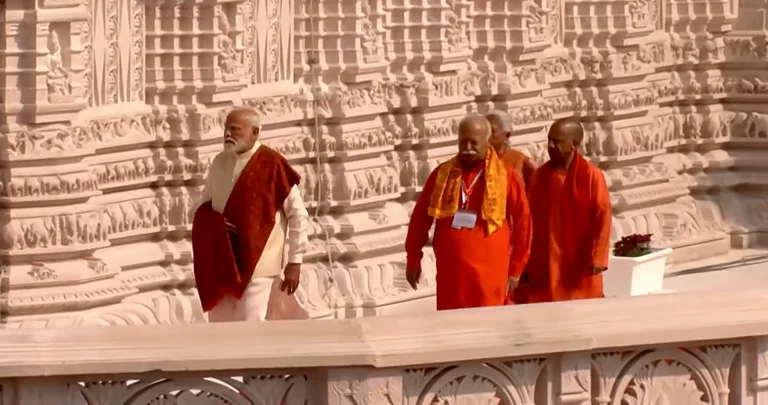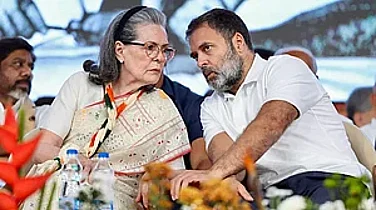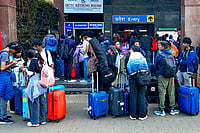The Lata Mangeshkar chowk in the heart of Ayodhya is a key navigation point for tourists. As one takes a walk from the chowk through Tedhi bazaar—a traditionally Muslim-dominated neighbourhood—one comes across scores of artists, painting symbols of Ram Rajya. There is a faded shade of saffron over the shutter gates of shops and Stores. Lights are being put up to make the roads glitzy at night. Ayodhya is undergoing a constant makeover even after the consecration ceremony.
But, amid all the transformation, there are stories of neglect. Towards the end of the Tedhi bazaar, as one stands in front of the Khatik temple or the Nishad mandir, both wearing their age with no signs of renovation or beautification, the Ayodhya story seems incomplete.
The Khatik and Nishad temples are among the 38-odd jati temples in Ayodhya that are run by Dalits, OBCs and other marginalised castes and communities. People of Ayodhya have various stories to tell about the origin of these temples. But the most common narrative that emerged was this. Almost a century ago, the temple town of Awadh was in the clutches of Brahmanvaad. This pushed the marginalised castes to build temples that would preserve the interests of the community.
For years, temple trustees and mahants, also hailing from the marginalised castes and communities, have been responsible for the maintenance and upkeep of these temples. But the journey had been full of challenges. They had hoped that the economic boom witnessed by Ayodhya 2.0 would rub on these jati temples, too. But it was not to be.
Over the past 35 years, the temple town has witnessed a clash between violence, spirituality and ideology and that has led to its eventual transformation. But nothing has changed for these jati temples that, for decades, have co-existed beautifully along with the structure and symbols that are synonymous with Ayodhya.
Take for instance the Prajapati mandir in Tedhi bazaar, just a few kilometers away from the location where the Babri Masjid once stood. Built over a century ago, it stands as a testimony to the syncretic culture of Ayodhya, both in its architecture and location. One can see the confluence of Indic and Persian styles on the temple gates, the corridor arches and the colours used to paint the walls. But beyond the colorful arched gates of the temple—run by people from the OBC community—exists a ghost of a crumbling legacy, loose mortar and the seer of the temple who has lost all hope.
A little ahead, the Yadav mandir is crumbling too. While many rejoice at the economic boom Ayodhya has witnessed, Sobhabharam Das, the mahant of the Yadav mandir, feels differently. “Their Ram ki nagri exists only on the main roads. In the narrow lanes of the Ayodhya dham, the Nagri is only a fiction,” he says.
Priests and trustees of many jati temples in Ayodhya have similar stories to tell. The mahant of Sant Ravidas—a Dalit temple—says the main source of their funding is the hostel they run in the neighborhood and the few devotees who visit during seasonal fairs, but it is not enough. “I have noticed that there are not many disciples in Jati temples. There is a clear crisis of succession,” says Deepak Gupta, a disciple at Sant Ravidas.
In a statement to the press, Rajendra Prasad Yadav, the deputy director of the tourism of Ayodhya division, had said ahead of the consecration ceremony that the state government has allocated around Rs 100 crore in the previous financial year to renovate temples and recreational spaces in the city to meet the demands of lakhs of pilgrims visiting the temple everyday. However, the mahants of the jati temples claim that they haven't received any funds from the tourism department.
Das, the mahant of the Yadav mandir, strongly feels that the Jati temples have no other consistent and reliable source of funding other than the small donations from visitors. But the footfall in these temples has not increased even after the consecration, and the temples are starving for funds and craving for attention. “The trustees have abandoned us. We have been wanting to renovate the campus for the past two years, but nothing has happened. More people would visit if we could refurbish the place,” he says.
He has been taking care of the only Radha-Krishna temple in Ayodhya for more than a decade. He takes pride in the fact that he caters to Krishna devotees in Ayodhya, whose history and the present have been intricately tied to Ram. He sees the beautification project as a grave injustice to his temple. While delighted at the Ram temple’s allure, he finds the government’s neglect especially piercing. “The coffers of the main temple are overflowing. Why can’t they use that money to beautify our temples?” he asks.
The Khatik temple, not far away from the Yadav temple, is facing similar issues. The temple trustees hope to erect a wall in an empty balcony to make rooms to lease out to students from minority castes, but their efforts have only failed so far. While elaborating on another grave issue, Santosh Kumar Pande, the mahant of the temple, says: “We have a small land outdoors that families can rent for marriages and feasts, but not everybody wants to rent from a backward caste.”
Many of the temples mentioned are on the road leading to the Lata Mangeshkar Chowk, but those in the interior lanes and by lanes face logistical and administrative roadblocks, too. The barricading and vehicular restrictions are restricting the entry of visitors. Many of their visitors used to come from nearby villages in lorries and tempos, but now they are not able to make it past the barricading.
The absent beautification is not the only problem; threats of land acquisition loom large. Take the case of the Nishad mandir, where Lord Nishad Raj, a significant figure in the Ramayana, is worshipped. To honor the community, the Ram Janmbhoomi Teerth Kshetra has proposed to construct a Nishad Raj temple in the main Ram temple premises. But Tulsi Das, the mahant of the temple for eight years, denied having any knowledge of the plan. He refuses to give up the land easily. “We know the trustees want to sell this land off,” he says. As a new temple is promised to the Nishad community, the old one’s future hangs in the balance.
Rambali Das, 68, has been the mahant of the Prajapati Ram-Janki mandir for forty years. He says that these days his family lives and bathes in the temple premises in the gaze of CCTV cameras installed by a lawyer who is eyeing to convert the temple into a guest house. “I have been fighting a case against the trustees to save this temple for many years,” says the old man who tends to one of the many oppressed caste temples in Ayodhya. “I hired a lawyer from Lucknow to help us. Since I am not educated. I did not realise when he gradually tricked us into registering the temple land in his name,” he says. Now, a board mentioning the name of the lawyer hangs outside the temple gates.
He has religiously served the temple community for four decades now. Devotees of the Prajapati community come to the temple during melas looking for cheap lodging and a sense of fraternity with the people of their caste. Most jati temples have been lively spaces for particular castes to gather, worship and stay together. These temples have also traditionally held annual panchayati sabhas to resolve internal conflicts. But now, the landscape is changing.
The mahant of Sant Ravidas mandir also mentions the constant threat from the land mafia. The trust of the temple has appealed several times to the local authorities to annul the cases against them but to no avail. Some people had come to Sant Ravidas temple and hung a photo frame of Ram. “We are happy for our Ram bhagwan, but I wish our temple would shine too when pilgrims come to Ayodhya,” says Das.
“It is alleged that back in the day, some portion of our land was forcibly taken by people from the upper caste,” says Chhatradas Kanaujiya of the Dhobi temple. Shiv Kumar, a trustee, says: “We somehow manage. We take a little bit from here, a little bit from there, and are somehow able to persist.”
The temple town is experiencing an overhaul since the Ram temple’s consecration. Property prices have shot up and real estate developers, hotel chains, corporates, and even Bollywood celebrities are looking to buy land in and around the Tedhibazaar. The Ram temple is embellished with lights and brimming with devotees, but the jati temples find themselves fighting for their legacy, their history, and their land.
Badri Narayan, a political scientist and a keen observer of caste politics, feels that the problem of jati temples goes beyond cut-and-dry electoral politics. He believes that the ruling party has tried to subalternise their politics and would naturally want to favour the development of these temples. “More than anything, this is a practical problem of lack of reach,” he says.
(Vidhi Bhutra is a journalism student in the Media Studies department, Ashoka University and a freelance writer.)























